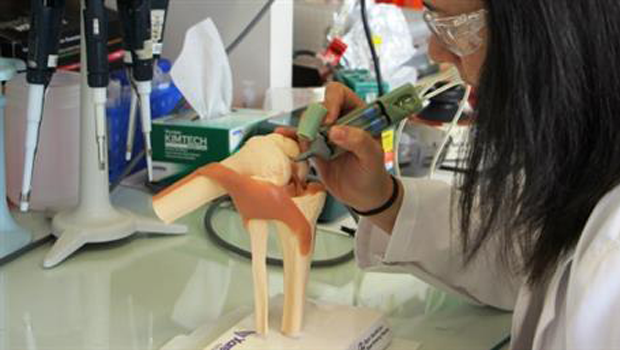A group of Australian surgeons and researchers has developed a 3D pen that allows surgeons to draw and sculpt customized cartilage implants made from actual human stem cells during live surgery. A mixture of hydrogel bioink and human stem cells are 3D printed directly into the patient’s body filling damaged cartilage with fresh cells that have a proven 97% survival rate and can actually heal the body over time.
Dubbed the ‘BioPen’, this landmark mobile 3D bioprinting device is developed by researchers from the ARC Centre of Excellence for Electromaterials Science and orthopaedic surgeons at St Vincent’s Hospital, Melbourne. This device could help reduce the hundreds of thousands of arthritis-related knee and hip replacement surgeries that take place every year, reducing medical expenses and eliminating the need for patients to undergo painful and invasive surgical procedures.

Arthritis is an extremely common condition affecting close to 350 million people worldwide. As their cartilage breaks down, arthritis sufferers can experience immense pain but since cartilage cannot re-grow itself, invasive surgeries that involve drilling into the bone or implanting pre-fabricated implants is often the only solution. Luckily, cartilage has no nerves or blood supply and that makes it a relatively simple tissue for 3D bioprinting applications. The major advantage of 3D printing BioPen is that it gives surgeons an unprecedented level of control and allows them to sculpt bespoke, 3D scaffolds directly into the wounded area.

“The BioPen project highlights both challenges and exciting opportunities in multidisciplinary research. When we get it right we can make extraordinary progress at a rapid rate,” said Professor Gordon Wallace, ACES Director.
As a “personalized intervention that encourages the body to heal itself,” the 3D printing BioPen could pave the way for the use of freeform 3D bioprinting during a range of surgical processes. In addition to 3D printing cartilage directly into arthritis patients, it could potentially be configured to 3D print other tissues, such as skin, muscles, or bone structures. Despite its small size, this 3D printing BioPen could represent one of the biggest breakthroughs in 3D printed medicine to date.
